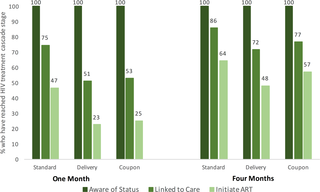PLOS Medicine ( IF 10.5 ) Pub Date : 2017-11-21 , DOI: 10.1371/journal.pmed.1002442 Michael M. Chanda , Katrina F. Ortblad , Magdalene Mwale , Steven Chongo , Catherine Kanchele , Nyambe Kamungoma , Andrew Fullem , Caitlin Dunn , Leah G. Barresi , Guy Harling , Till Bärnighausen , Catherine E. Oldenburg

|
Background
HIV self-testing (HIVST) may play a role in addressing gaps in HIV testing coverage and as an entry point for HIV prevention services. We conducted a cluster randomized trial of 2 HIVST distribution mechanisms compared to the standard of care among female sex workers (FSWs) in Zambia.
Methods and findings
Trained peer educators in Kapiri Mposhi, Chirundu, and Livingstone, Zambia, each recruited 6 FSW participants. Peer educator–FSW groups were randomized to 1 of 3 arms: (1) delivery (direct distribution of an oral HIVST from the peer educator), (2) coupon (a coupon for collection of an oral HIVST from a health clinic/pharmacy), or (3) standard-of-care HIV testing. Participants in the 2 HIVST arms received 2 kits: 1 at baseline and 1 at 10 weeks. The primary outcome was any self-reported HIV testing in the past month at the 1- and 4-month visits, as HIVST can replace other types of HIV testing. Secondary outcomes included linkage to care, HIVST use in the HIVST arms, and adverse events. Participants completed questionnaires at 1 and 4 months following peer educator interventions. In all, 965 participants were enrolled between September 16 and October 12, 2016 (delivery, N = 316; coupon, N = 329; standard of care, N = 320); 20% had never tested for HIV. Overall HIV testing at 1 month was 94.9% in the delivery arm, 84.4% in the coupon arm, and 88.5% in the standard-of-care arm (delivery versus standard of care risk ratio [RR] = 1.07, 95% CI 0.99–1.15, P = 0.10; coupon versus standard of care RR = 0.95, 95% CI 0.86–1.05, P = 0.29; delivery versus coupon RR = 1.13, 95% CI 1.04–1.22, P = 0.005). Four-month rates were 84.1% for the delivery arm, 79.8% for the coupon arm, and 75.1% for the standard-of-care arm (delivery versus standard of care RR = 1.11, 95% CI 0.98–1.27, P = 0.11; coupon versus standard of care RR = 1.06, 95% CI 0.92–1.22, P = 0.42; delivery versus coupon RR = 1.05, 95% CI 0.94–1.18, P = 0.40). At 1 month, the majority of HIV tests were self-tests (88.4%). HIV self-test use was higher in the delivery arm compared to the coupon arm (RR = 1.14, 95% CI 1.05–1.23, P = 0.001) at 1 month, but there was no difference at 4 months. Among participants reporting a positive HIV test at 1 (N = 144) and 4 months (N = 235), linkage to care was non-significantly lower in the 2 HIVST arms compared to the standard-of-care arm. There were 4 instances of intimate partner violence related to study participation, 3 of which were related to HIV self-test use. Limitations include the self-reported nature of study outcomes and overall high uptake of HIV testing.
Conclusions
In this study among FSWs in Zambia, we found that HIVST was acceptable and accessible. However, HIVST may not substantially increase HIV cascade progression in contexts where overall testing and linkage are already high.
Trial registration
ClinicalTrials.gov NCT02827240
中文翻译:

赞比亚女性性工作者中的艾滋病毒自我测试:一项整群随机对照试验
背景
艾滋病毒自检(HIVST)可能在弥补艾滋病毒检测覆盖率方面的不足以及作为艾滋病毒预防服务的切入点中发挥作用。与赞比亚女性性工作者的护理标准相比,我们进行了2种HIVST分布机制的整群随机试验。
方法和发现
在Chirundu的Kapiri Mposhi和赞比亚的利文斯通接受过培训的同伴教育者,每人招募了6名FSW参与者。同行教育者–FSW组被随机分配到3组中的1组:(1)分娩(从同伴教育者那里直接分发口服HIVST),(2)优惠券(从卫生诊所/药房收集口服HIVST的优惠券) ,或(3)护理标准HIV测试。2个HIVST小组的参与者收到2个试剂盒:基线时1个,第10周时1个。主要结果是在过去的一个月和四个月的访问中进行的任何自我报告的HIV检测,因为HIVST可以替代其他类型的HIV检测。次要结果包括与护理的联系,在HIVST武器中使用HIVST以及不良事件。参加者在同伴教育者干预后的1和4个月内完成了问卷调查。在所有,N = 316; 优惠券,N = 329;护理标准,N = 320);20%的人从未接受过HIV检测。分娩组在1个月时的总体HIV检测率为94.9%,优惠券组为84.4%,护理标准组为88.5%(分娩与护理标准的风险比[RR] = 1.07,95%CI 0.99) –1.15,P = 0.10;优惠券对护理标准RR = 0.95,95 %CI 0.86–1.05,P = 0.29;分娩对优惠券RR = 1.13,95%CI 1.04–1.22,P = 0.005)。分娩组的四个月率为84.1%,优惠券组为79.8%,护理标准组为75.1%(分娩与护理标准RR = 1.11,95%CI 0.98–1.27,P = 0.11 ;优惠券与护理标准RR = 1.06,95%CI 0.92–1.22,P = 0.42;交付与优惠券RR = 1.05,95%CI 0.94-1.18,P = 0.40)。在1个月时,大多数HIV检测是自我检测(88.4%)。1个月时分娩组的HIV自我检测使用率高于息票组(RR = 1.14,95%CI 1.05–1.23,P = 0.001),但4个月无差异。与会人员相比,在2个HIVSTST组中,在1个(N = 144)和4个月(N = 235)的HIV检测呈阳性的参与者中,与护理的联系显着降低。有4例与参与研究有关的亲密伴侣暴力事件,其中3例与使用HIV自测有关。局限性包括研究结果的自我报告性质和对HIV检测的总体接受程度高。
结论
在赞比亚FSW中的这项研究中,我们发现HIVST是可以接受的且可访问的。但是,在整体测试和联系已经很高的情况下,HIVST可能不会显着增加HIV级联进展。
试用注册
ClinicalTrials.gov NCT02827240







































 京公网安备 11010802027423号
京公网安备 11010802027423号